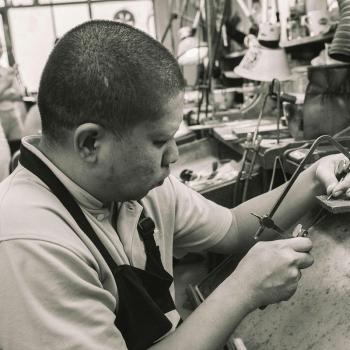Was Jesus Homeless? Yes, no, and kind of. The answer is more interesting than you’d think.

Jesus says in Matthew 8:20 NRSV, “Foxes have holes, and birds of the air have nests; but the Son of Man has nowhere to lay his head.” Quoting this scripture, many people claim that Jesus was homeless. In the United States, December 3 is National Roof-Over-Your-Head Day. It’s a time to be thankful if you have a place to call home. It’s also a time to remember those with nowhere to lay their head. Here’s what the Bible has to say about whether or not Jesus was homeless.
Yes, Jesus Experienced Homelessness
- Jesus was literally born in a barn. You can’t get more homeless than that. Every year at this time, Jesus’ followers set up manger scenes. They sing “Silent Night” and send Christmas cards depicting the baby in a manger. Many don’t realize that this means the Christ Child was homeless. Of course, Jesus’ foster father, Joseph, had a home in Nazareth. But Jesus was born into homelessness.
- Jesus wasn’t just homeless—he was a refugee. By the time the magi visited, Joseph and Mary were no longer in the barn. They were in a house. But that time of being properly sheltered was short-lived. When the magi left, Joseph had a dream in which an angel warned him to take his family and flee Bethlehem because of Herod’s murderous plans. They exchanged their security for a life of homelessness, becoming refugees in Egypt for a couple of years until the vicious king died.
- Jesus chose to live a homeless lifestyle. Matthew 8:20 records Jesus saying he had no place to lay his head, Luke 9:58 echoes this testimony word for word. Most people who experience homelessness don’t actually choose to live unsheltered. However, there is a small percentage that decides to live out of doors. In my article, “What Jesus Said to the Homeless Man,” I discuss how Jesus ministered to one man whose mental illness drove him to live in caves that were used as tombs. Jesus had such a heart for people experiencing homelessness that he chose to sleep rough most of the time as he preached from town to town.
No, Jesus Wasn’t Homeless
- Jesus had a family home. Jesus didn’t live most of his life in a homeless condition. His foster father, Joseph, was a carpenter who likely owned his own shop. In Mark 6:3, the people in his hometown of Nazareth called him a carpenter. In Matthew 13:55, the people called him the “carpenter’s son.” Jesus likely learned his trade in his father’s shop, which required a home.
- Friends welcomed Jesus as he traveled. While Jesus said he had no place to lay his head, this was likely hyperbole. While he often camped out while traveling with his disciples, he also had friends who opened their homes to him. Mary, Martha, and Lazarus frequently hosted Jesus and his disciples at their home in Bethany. You might say that this large dwelling served as one of several home bases. Jesus also stayed at the house of Peter in Capernaum, at the home of Zacchaeus in Jericho, at Levi’s house, and others.
- Jesus had a home with his family. In Matthew 12:46-48; Mark 3:30-33; and Luke 8:19-21, Jesus’ family came to speak with him after people gossiped that he had a demon. Many commentators believe they came to take him back home to live with them. He had become an embarrassment to them, and they wanted to quiet the crowds. In addition, his absence from the carpenter’s shop no doubt had an economic impact on the family. They came to take him home and to let him know he always had a place with them. Of course, he disappointed them with his refusal.
- Jesus had a home. In Mark 2:1, Jesus was in Capernaum and the people heard that Jesus was “home.” Some friends of a man with a disability found it impossible to get into Jesus’ home due to the crowds. So, they climbed up to the roof, ripped a hole in it, and lowered their friend down through the hole. The first thing Jesus said was, “Your sins are forgiven,” indicating that they had sinned against him by damaging his roof. We don’t know if Jesus owned this home or if he rented it— but the Bible does call it his home.
Kind of Homeless
When I worked as a housing case manager, part of my job was to determine if clients were literally homeless, according to the HUD definition. I also helped determine if they were chronically homeless, according to the HUD definition. Whether Jesus was literally homeless, chronically homeless, or neither of these—there is another way in which we can understand the homelessness of Christ.
In Matthew 25:40 NRSV, Jesus says, “Truly I tell you, just as you did it to one of the least of these who are members of my family, you did it to me.” By this, Jesus taught that he is mystically present in every member of the human family. Jesus repeated this concept when he appeared to Saul on the Damascus road, saying, “Saul, Saul, why do you persecute me?” Saul had been imprisoning and even killing Christians, but Jesus told him that it was Jesus himself who felt the damage. Jesus also said that anyone who welcomes a child in his name actually welcomes Jesus himself (Matthew 18:5). In other words, Jesus identifies with the plight of the weakest, most vulnerable, and those who are considered the “least.”
In this way, we can understand that every person experiencing homelessness is actually Jesus, in a manner of speaking. When we help unsheltered people in our neighborhoods, we are touching God. When we feed hungry people, we are feeding Christ. On National Roof-Over-Your-Head Day, and every day of the year, Christians who have their own housing should be grateful for the shelter they usually take for granted. But more than that, followers of Jesus can look into ways to help houseless people in their own community. Click here for “7 Practical Ways You Can Help People Experiencing Homelessness,” by John Lingan. This week after US Thanksgiving, I hope you’ll be thankful for the housing that you have. And I hope you’ll see the face of Jesus in every person who experiences homelessness.













